Where were you born? Durban, South Africa
Favourite Hobby? Music Production
Favourite Quote? "I can’t quote the equations of General Relativity from memory, but nonetheless if I walk off a cliff, I’ll fall." - Eliezer Yudkowsky
Favourite Band? The Brian Blade Fellowship
Favourite Food? King Fish Sashimi
Post-pandemic - Where Do You Want To Travel First? Iceland - some of my favorite sci-fi movies were filmed in Iceland plus I'm a fan of a few musicians from there
What's a fun fact people may not know? I can ride a unicycle at a skatepark
What’s your favorite part about your job at Truckit? Building features that use geo data
Almost every truck driver has an idea on the best way to conserve fuel. Some methods are tried and true, others work for some and not for others. Nevertheless, saving fuel is an important part of being a driver or business owner. It is no secret that fuel is the No. 1 expense when driving a truck.
We’ve compiled 6 of the most common tried and true ways that drivers have improved their fuel economy so you don’t have to.
More than any other habit, excessive speeding burns the most fuel, and also causes more significant wear and tear. This is because when a driver is following the vehicle in front of them at an unsafe distance, they brake and accelerate excessively to avoid tailgating and collisions. Increasing speed from 90km/h to 105km/h can raise fuel consumption by as much as 15%. Additionally, watch your driving style and reduce speed changes as regular speed changes cause the engine to switch gears inefficiently, resulting in a spike in RPM and a surge in fuel consumption.
If you don’t trust yourself in picking up on these habits, there are cameras you can purchase and install in your truck that track these habits for you, identifies them, and notifies you so you can work on them. One example of this camera would be Driver Risk’s Lytx DriveCam vehicle tracking device.
2. Tracking your Fuel Consumption
There are many great apps on the market to assist you in managing your vehicle's fuel economy. We recently wrote a blog: Useful apps for Truckers, where we mention an app called Fuelly. Fuelly is a great app if you are a driver who avidly check’s the vehicle's performance and maintenance. This app tracks your petrol use and compares results over time to show you whether or not your vehicle is performing at its best, and if your fuel consumption has changed. To read more about this app and its other features, check out the blog here.
3. Reduce your Idle Time
There is a common misconception that idling is more fuel-efficient than restarting the engine. In fact, idling a truck for just 10 seconds requires more fuel than starting the engine. Reducing your idling also saves unnecessary carbon dioxide emissions as well as reducing your fuel costs.
4. Tyres
Under inflated tyres can exert a serious impact on fuel consumption. According to the National Highway Traffic Safety Administration (NHTSA), a 10% reduction in recommended tyre pressure can reduce fuel efficiency by 2%.
5. Use the Most Efficient Routes
We think this goes without saying, but ensuring you’re taking the most efficient routes is essential to improving the average fuel economy of your fleet. Pre-plan your route, plan where you are stopping and where the cheapest fuel is will assist you in cutting your costs.
6. Maintenance
Regular maintenance is essential for ensuring the longevity of your vehicle and making sure it is operating at maximum efficiency. If you don’t stay on top of maintenance, the excessive wear of your vehicle can produce more expensive costs than the price for a tank of fuel.
Make this a priority!
If you have any other tips we have missed, comment them below!
Find your next job here, with Truckit: https://www.truckit.net/search-for-jobs
Living on the road can be tough for truck drivers. Luckily, there are many trucker apps that are designed to support truck drivers. There are so many different apps out there, so we took it upon ourselves to find you the best and most reputable apps that navigate, manage your fuel, find you rest stops, manage fatigue & find a good feed!
Apps to make your trips easier
Toilet Finder
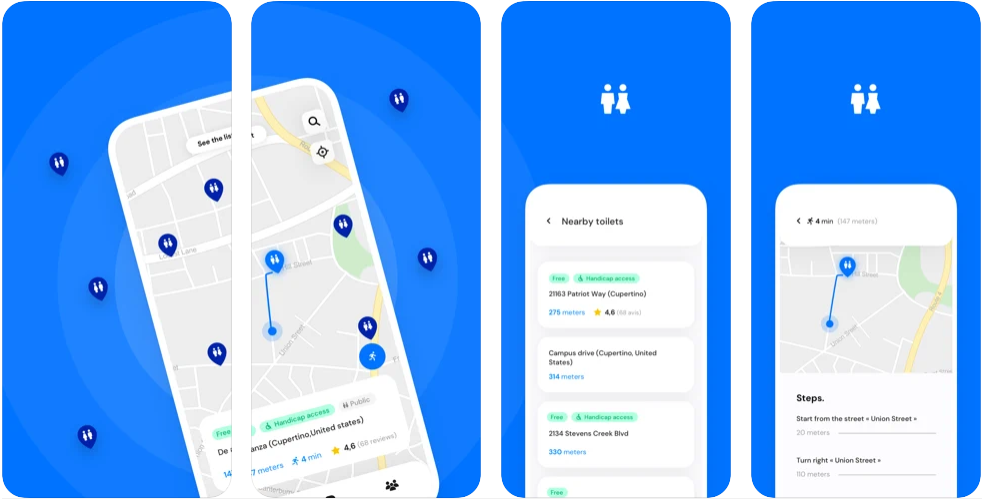
Toilet Finder is an international community group who together have found over 150,000 toilets around Australia and the rest of the world. The app is completely free to use, and you can add to the list of undiscovered toilets, including being able to rate them. Now you can find a clean toilet stop with ease with the help of fellow truckers!
Sygic Truck & Caravan
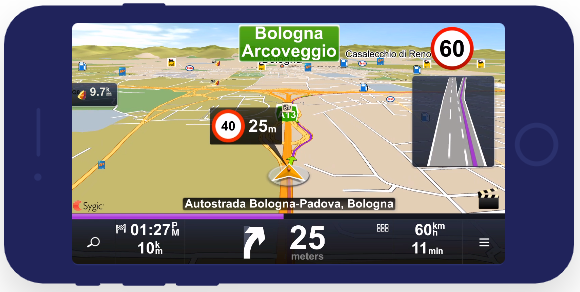
Sygic Truck and Caravan is a high quality GPS navigation app that is designed for professional drivers and their larger vehicles. It is trusted by 2 million drivers of trucks, lorries, LGV’s, HGV’s, RVs, Caravans, Campers, Vans, Buses, Cars & many more of the world’s leading delivery fleets. What makes it stand out from the others is it has 3D offline maps meaning you can access the app and its features without the use of internet or mobile data. The maps they use are also updated throughout the year so they can make sure they are providing you with the most up-to-date road conditions.
Sygic also offers special routing for Trucks/Lorries/LGV’s/HGV’s and delivery vans that are specifically calculated for the vehicle and it’s load. With this, when you search for your destination, it will present you with 3 alternative routes that display the total driving time, distance, and elevation of the route. Along these routes it also includes petrol stations, weight stations and rest areas that are best suited for your journey.
If you weren’t already sold on this basically ‘all inclusive’ app, their advanced route planning includes avoiding tolls, U-turns, hazards such as low bridges, narrow roads, or restricted areas such as emission zones and school zones. Also included in the advanced route planning is the curated planning and optimisation for multi-stop routes. You can add up to 150 waypoints and they will be rearranged for you, to achieve the best efficiency.
To make sure it is safe for truckers to use whilst driving, the maps have spoken voice instructions with road indication, speed limits and speed camera warnings. Their live map services include real-time traffic information, mobile speed camera databases, fuel pricing and parking places.
The best part is that the app is extremely affordable. Whilst some aspects of the app are free, the premium features are an affordable $28.99 for an entire year, which is less than $2.50 per month!
Apps to save you fuel
MotorMouth
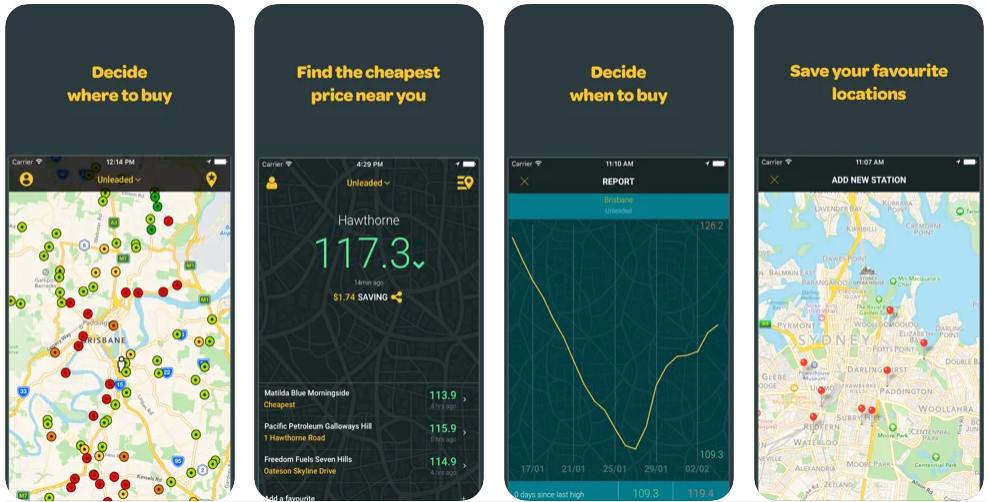
MotorMouth identifies your location and finds the cheapest fuel closest to you. It tracks trends and creates forecasts to notify you when fuel will be cheapest and whether it is at your local petrol stations, or at another nearby location. This app is great as it utilises a rewards system. If you record the price of petrol when you fill up on the app, you can earn 5 fuel credit points, and an extra 5 if you confirm the price with a photo!
Fuelly
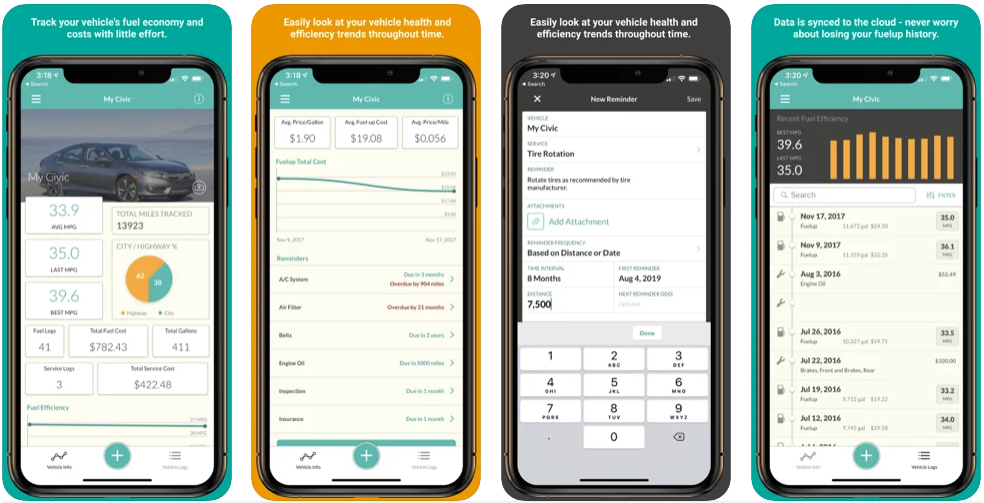
Fuelly is a great app if you are a driver who avidly check’s the vehicle's performance and maintenance. This app tracks your petrol use and compares results over time to show you whether or not your vehicle is performing at its best, and if your fuel consumption has changed. This data also then becomes a part of a community database where other drivers can compare their fuel consumption. Additionally, you can set up the app to send you reminders to keep on tip of maintenance tasks such as oil changes and tyre rotations.
Fuelly also provides a premium service which removes ads, adds photos and PDFs to personal app records and provides priority support within app messaging.
The app starts at 0.99 cents per month and $6.99 annually. All in all, a very affordable app.
Apps to help with fatigue management
Logbook Checker
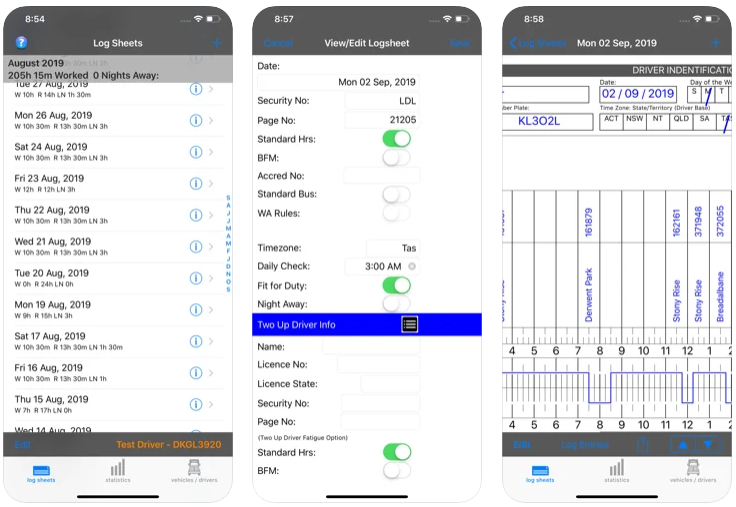
Logbook Checker app, is in fact, a log book checker. It makes note of your logbook and warns you about your rest breaks and how much driving time you have remaining in your work day. It simultaneously handles different types of fatigue management systems (basic fatigue management, advanced fatigue management, standard hours and WA rulesets).
Best part of the app - it’s free!
Test Your Tired Self
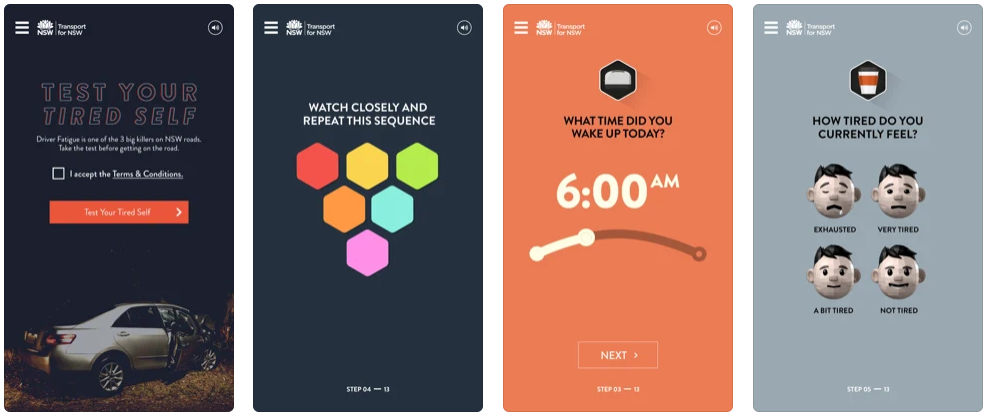
Fatigue management is an important part of long haul drives. This app has games dedicated to truckers fatigue management which include reaction times, sleeping patterns, focus & memory testing. Inclusive of this, during the games, fatigue facts pop up to make sure you are informed of all things fatigue management.
Need a feed?
TheFork
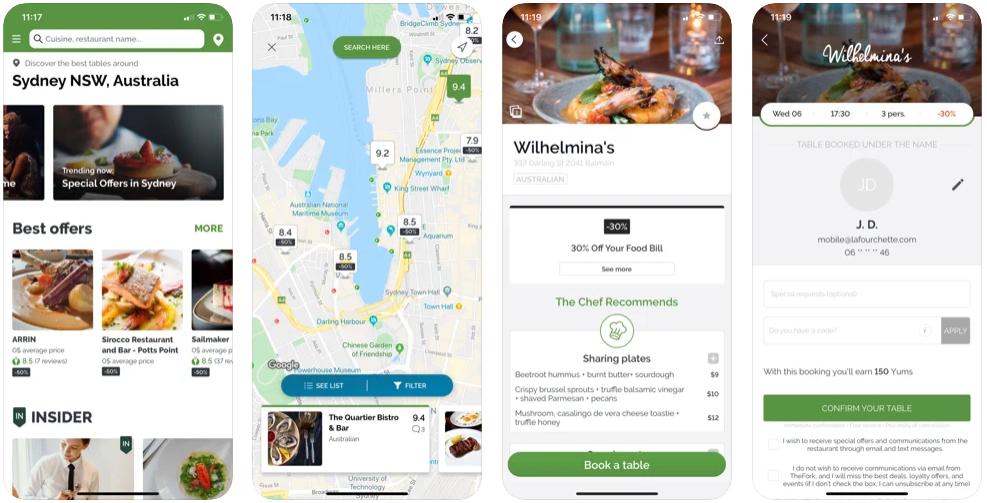
TheFork is a renowned restaurant bookings app. They are partnered with over 4,500 restaurants across Australia and commonly have discounts of up to 50% off. It is a great app for someone who eats out a lot and loves a free meal. Using TheFork, you can accumulate ‘Yums’ points: 1 app booking is equal to 150 Yums and 1 desktop or mobile website booking is equal to 50 Yums. 1000 Yums gets you a $20 discount on your next meal, and 2000 Yums will get you a $50 discount!
Where were you born? Brisbane, Queensland
What are your favourite hobbies? Playing video games, reading, live music & seeing friends!
In a post-pandemic world, where do you want to travel first? France, maybe the Netherlands. I want to see all of the art galleries and see the pretty buildings
What is your favourite food? Cheese Pizza
Do you have a favourite band? Tool
What is a quote that means most to you? Change your thoughts, change the world
Do you have any fun facts that people may not know about you? I am a crazy cat lady but only have ONE cat, I have 24 tattoos & I have met John Jarratt
What's your favourite part about your job at Truckit? Being able to resolve issues for our customers & providers, alongside the cool people I work with
If you need assistance with your listings or bookings - call our amazing customer service team today on 1300 859 850
There is no denying that freight drivers spend significant periods of time on the road. In 2020, Budget Direct recorded an estimate of 23,499 million kilometres travelled by all freight vehicles. With such a high estimate, we did some digging to see what these incredible drivers get up to, to keep themselves entertained whilst on the road.
Podcasts & Audio Books
Without the company of family and friends on the road, finding quality podcasts or audiobooks are an engaging way to stay alert on the road, but also to learn new topics like historical periods, have a laugh and keep yourself informed. In 2021, some podcasts that made it into Australia’s top 10 were Casefile True Crime, Hamish & Andy, The Update, Triple M Rocks Footy AFL and She’s on the Money.
Music Streaming
Music streaming, not unlike podcasts and audio books, can be utilised whilst driving or during breaks. This is a great hands free option for de-stressing, boosting your mood and also creating a more positive and engaging environment to drive in, especially for those who don’t like sitting in silence with their own thoughts, or prefer to choose their own curated music playlists over the radio.
Self-Reflection
Very few people take time out of their day to practice self-reflection & gratitude. Truck Drivers on the other hand have ample time to do just this, and can be a different way of keeping the mind occupied whilst keeping their full attention on the road.
Mobile Games
After travelling long distances, it’s nice to take a break and take your mind off of work. Although many might say that staring at a screen for too long can be detrimental to your health, it also is known to have health benefits such as stress relief, reducing depression and improving your mood. Furthermore, if you play an online mobile game, it allows you to connect with people and collaborate in problem solving - increasing your creative output. As drivers spend so much time on the road and not on their phones, I think it’s safe to say that the positive impacts of mobile games outweigh the negative!
Social Media & Vlogging
In recent years, more truck drivers are becoming social media influencers. More times than not the decision to become an influencer stems from wanting to share industry advice, industry news, provide humorous entertainment, and to create a community. Using their voices, backed by their following and community, these influencers have a common goal of educating, motivating and empowering truckers so they can stand up for their rights all whilst bringing public awareness to these issues in an attempt to bring about change.
Photography
Taking a break between trips is vital when driving long distances. During these breaks, some drivers take a moment to stretch their legs and take in their surrounds. Dependent on how far and where they have travelled, the landscapes or wildlife they may encounter can vary from town to town & state to state. This is a great chance to not only capture a momento of the moment, but to hone those photography skills through shooting different climates & angles!
Exercise
Sitting down for long periods of time can affect a person's health. As truck drivers require rest periods as a part of their trip, some have taken to hiking as for their break as an alternative to the typical gym session. Hiking and walking trails can be very common in rural areas so they should be easy to find, and the fresh air will allow for a fresh mind once the driving starts again. Before your next trip, research some hiking trails along your route to see where you can take your next break!
Novel Writing
Quite possibly through self reflection, some drivers have taken to writing novels during their breaks on the road. New apps have been developed where drivers can speak to their phone whilst keeping their eyes on the road and hands on the wheel, and the app transcribes speech to text. So if you’re on the road and think of a fantastic story idea, be sure to check out Transcribe, Dictation & Otter (to name a few).
Collecting Souvenirs
Collective souvenirs like fridge magnets, town maps or postcards can keep a long-distance driver occupied as they can look forward to each town they drive through. Souvenirs like these are typically held in the local information buildings, therefore subliminally educating anyone who walks through those doors. Not only are they collecting proof of these towns' existence, but also learning the story of its making to take home to share with friends and family whenever they point out the collection.
We'd love to know what you get up to during your time on the road - feel free to reach out to marketing@truckit.net and let us know!
Now is the time when Australia needs you. If you have thought about a career in truck driving, there has never been a better time to take the leap. If you’re still not convinced - here are top benefits of being a truck driver!
Many Australians hold onto the dream of travelling Australia by road. One of the job profiles that have this privilege, is the job of a truck driver. Not only will you be able to adventure in the beautiful land we call home and meet new people along the way, but you can do all of this while earning a good income.
2. Income
Truck drivers in Australia can earn a decent living. Don’t go thinking it is easy money, however. Truck driving is challenging and involves long-distance journeys, long night shifts, days or weeks away from home, but if you are somebody who is up for a new challenge, you will earn every cent paid your way. According to statistics, the average salary for a heavy vehicle driver in Australia is $61,000, which is higher than average. The highest paying truck driving jobs would be the heavy combination (HC) & multi-combination (MC) truck drivers, whose average annual salary sits approximately between $80,000 to $120,000.
3. Freedom & Flexibility
One of the greatest benefits of being a truck driver is having more control over your working schedule, compared to previous employment. As long as you don’t compromise your work, and within means, most companies allow you to create a flexible schedule that fits your routine.
With Truckit, you have a choice in the types of loads you want to run, where you want to go, how long you want to be on the road, and so on. That being said, that also means you have more responsibility. You are responsible for maintenance costs as well as potential breakdowns that could occur.
4. Job Security
With Australia’s increased demand for truck transportation, and as long as people need items transported, truck driving jobs aren’t going anywhere! There is also plenty of room for progression, if you are starting in the beginner ranks, there are five different truck licences that you can attain over the course of your career; LR: Light Rigid, MR: Medium Rigid, HR: Heavy Rigid, HC: Heavy-Combination & MC: Multi-Combination.
5. Learning Potential
The average truck driver is in their 50’s, with many who will be retiring over the next 10 to 15 years. This leaves a lot of potential for younger drivers to learn the ranks. The legal age to drive trucks within the industry is 25, but the Australian Government has just implemented an apprenticeship scheme for young drivers who are willing to wait out until they are of age. In December of 2021, the government cleared the road for a new truck driving apprenticeship following calls from the Australian transport sector for a nationally agreed qualification to meet future workforce challenges, not unlike the current covid-19 supply shortages. This is a new approach to ensure the transport industry has the workforce of the future, and provides young Australians with the opportunity to have a career, not just a job in a rewarding industry.
To read more on the apprenticeship, click here. http://pm.gov.au/media/new-trucking-apprenticeship-keep-driving-australias-economy
5. Purpose
If COVID-19 has taught us anything, it is that being a truck driver is more essential than ever before. Without our drivers - the industry, the country, and every individual would be impacted. Truckit is incredibly appreciative of the dedicated truck drivers who are continuously driving Australia forward.
The trucking sector drives the Australian economy, and there has never been a better time to join the ride!
Without trucks, Australia stops.
At Truckit we want to help you show potential users that you will go above and beyond to give them a more personalised experience.
A picture speaks a thousand words, and can also increase your chance of securing a job by over 50 percent. We recommend uploading a profile picture that includes your face. If you choose to upload more, you could also showcase yourself, your vehicles, or some of the interesting loads you have transported. Using this feature on your profile will allow a more comprehensive view of who you are, including your skills and experience, providing the user more bang for their buck.
To assist you in taking the best possible profile picture, we have compiled some industry pro-tips below!
1. Show Your Face
This may sound obvious, but it isn’t uncommon to find profile pictures that require you to zoom in, only to be faced with indecipherable pixels. Your picture could be taken whilst you participate in a hobby, or in the workplace - as long as there is a clear view of your face. You want to make the point to users that you are also a human being wanting to provide an excellent service; working to support themselves and their families.

2. Use Contrasting Colours
If you have decided to take a more professional profile picture with a more basic background, contrasting colours are a great way to draw people’s attention. To ensure that it will stand out, be aware of the platform's key colour scheme where you are posting your picture. For some insight, check out the colour wheel below!

3. Smile!
Research has shown that people who have bigger smiles in their profile pictures have greater social connections and relationships, so make sure you flash those pearly whites!

4. Why stop at just 1 picture?
You can upload a gallery of pictures to your Truckit profile to help show off your vehicles, your professionalism and examples of things you have moved previously. Having a variety of pictures can give the customer incentive to choose your quote as you are showcasing your experience!
We hope these pro-tips helped you take your ultimate profile picture!
Summer trucking can be challenging.
During this hot season, it is important that truck drivers establish ways to keep themselves safe. Take time to practice these summer safety tips to significantly reduce a potential road accident and health problems.
1. Hydrate Frequently
High heat and humidity increases perspiration.
2. Protect Yourself Against The Sun
Sunlight shining through windows can lead to sunburn and can have a significant impact on someone's health.
3. Watch Out For Extra Drivers
In the summer months, there are more people on the road than any other season.
4. Keep Tires Properly Inflated
Tire blowouts aren't uncommon in the extreme heat.
5. Check The Brakes
Hot temperatures can lead to brake fading or the loss of friction when brake component can't absorb the heat.
6. Protect Your Eyes
Direct sunlight can cause your cause your eyes to become quickly irritated.
Follow these truck driving safety tips to help you beat the heat this summer!
Each year, almost 40,000 Australians relocate across the country. Moving is stressful enough without the extra pressure created by transporting your precious goods to another state. According to realestate.com - moving interstate by road is generally considered one of the easiest, most convenient and more affordable ways to move. If you are working with a budget this will be your more ideal choice, plus - you can save more money by sharing a truck or container with other movers who you can find on Truckit.net.
Following these steps will help to reduce the stress of moving interstate. The first step is to section off weeks leading up to your moving day, 6-8 weeks away, 2-4 weeks away, 1 week away, and then on the day.
6-8 Weeks Before Moving Day
Set a moving budget
Moving interstate can be financially straining so be more prepared by creating a reasonable and achievable budget that fits within your means. Make sure you factor in removalists, packing materials, removalists cleaners & insurance to name a few.
Book your movers
Truckit makes it easy to find quotes that are best suited to you. Using Truckit.net, you can simply create a free listing, receive competitive quotes, compare and choose a provider, and from there - manage, receive & rate!
Organise booking insurance
Truckit does not directly protect Customers/Buyers against damages to their items, however Truckit does partner with NTI to protect Customers/Buyers against damages for most items. Alternatively, your transport provider may have their own warranty or insurance process which you can utilise at your own due diligence.
2-4 Weeks Before Moving Day
Book a removalist cleaner
When you’re in the height of packing and getting ready to move, people tend to mentally check out and leave things as they are as it can be viewed as a daunting task. Hiring a removalist cleaner can take that burden from you so you can focus on more important aspects of the move. Professional cleaners also use more industrial strength materials, leaving your house cleaner than if you cleaned it yourself, and they will remember to clean the forgotten aspects like sliding door/window tracks and the stove range hood!
Organise your new address
To minimise the risk of lost bills or other important documents, don’t forget to change your address. This may sound like a no-brainer, you change it for your utilities, license, work, and bank, but have you remembered to change your address on your ATO or MyGov account? You may not use these features often, but more often than not it is at the times you think you don’t need these services, you end up needing them. Another commonly forgotten address change is your toll badge which is especially important if you are driving long-haul to your new state. A safeguard for forgetting to change your address for important instances is leaving a forwarding address so everything is redirected to your new location.
Declutter & sell, donate or discard unwanted items
Us humans are notorious for collecting clutter so you should surely have items hiding throughout your house that you definitely don’t need or use. During decluttering, be ruthless and go full Marie Kondo - does it give you joy? When was the last time you saw or used this item? This process not only saves you on packaging and moving costs, but you can also gain some extra income to assist in the move! We recently released a blog post on Moving: Can you do it sustainably? Which you can check out for more helpful tips for the decluttering process.
Sort out packing supplies
Now that you have culled all unnecessary items, there should be a smaller amount to pack, and therefore it should be easier to organise what packing materials are needed like boxes, bubble wrap, tape & paper. If you are wanting to cut costs in this process, it would be ideal to reach out to friends or family asking if they have any reusable packing materials to share, or for a more sustainable option, you can utilise blankets, sheets and towels you already own to wrap more fragile items. To maximise packing space, using materials like towels, blankets or older clothing items will save you from using excess packing materials you don’t necessarily need.
Create an inventory
Having an inventory is important, especially if you have a large space. This allows you to tick off items at your new location to be sure that everything made it safely and nothing is missing. If items have gone missing, having an inventory checklist makes it easier to identify what needs to be found. The easiest way to do this is whilst you are packing. Have lists of what is in each box, and make sure those boxes are clearly labelled. When you are finished packing items, keep them all in one space to ensure you don’t double up your inventory!
1 Week Before Moving Day
Create a plan for moving day
Creating a moving plan can allow you to have total control of the day, henceforth freeing your mind of any extra stress. An example of a moving day checklist will be provided further below for what to do on the day you move!
Confirm your removalists and the removalist cleaners
Make sure your removalists and removalist cleaners are still aware of your need for them, and that they have the correct dates, addresses & times. This will help plan out your moving day, whilst also assuring that they will show up on the day and that your booking hasn’t been missed.
Packing
Packing in advance will allow for a smooth moving day. You can hire removalists with a full packing service, however if you choose to pack yourself, follow these tips below:
Pantry & fridge
At this point in time you should have already begun to reduce the food and drink that lives in your fridge and pantry. Make note of what items you have left, and how you can potentially use them before moving day. If you can’t use any of the items before moving day and do not want to take them with you, you can give them to friends or family, donate to the Foodbank if long life, or dispose of them accordingly.
Moving Day!
Now that moving day is upon you, it is time to put that moving day checklist to action!
We hope these tips help you in your next interstate move!
To help you move more sustainably, check our blog post: Moving: Can you do it sustainably?